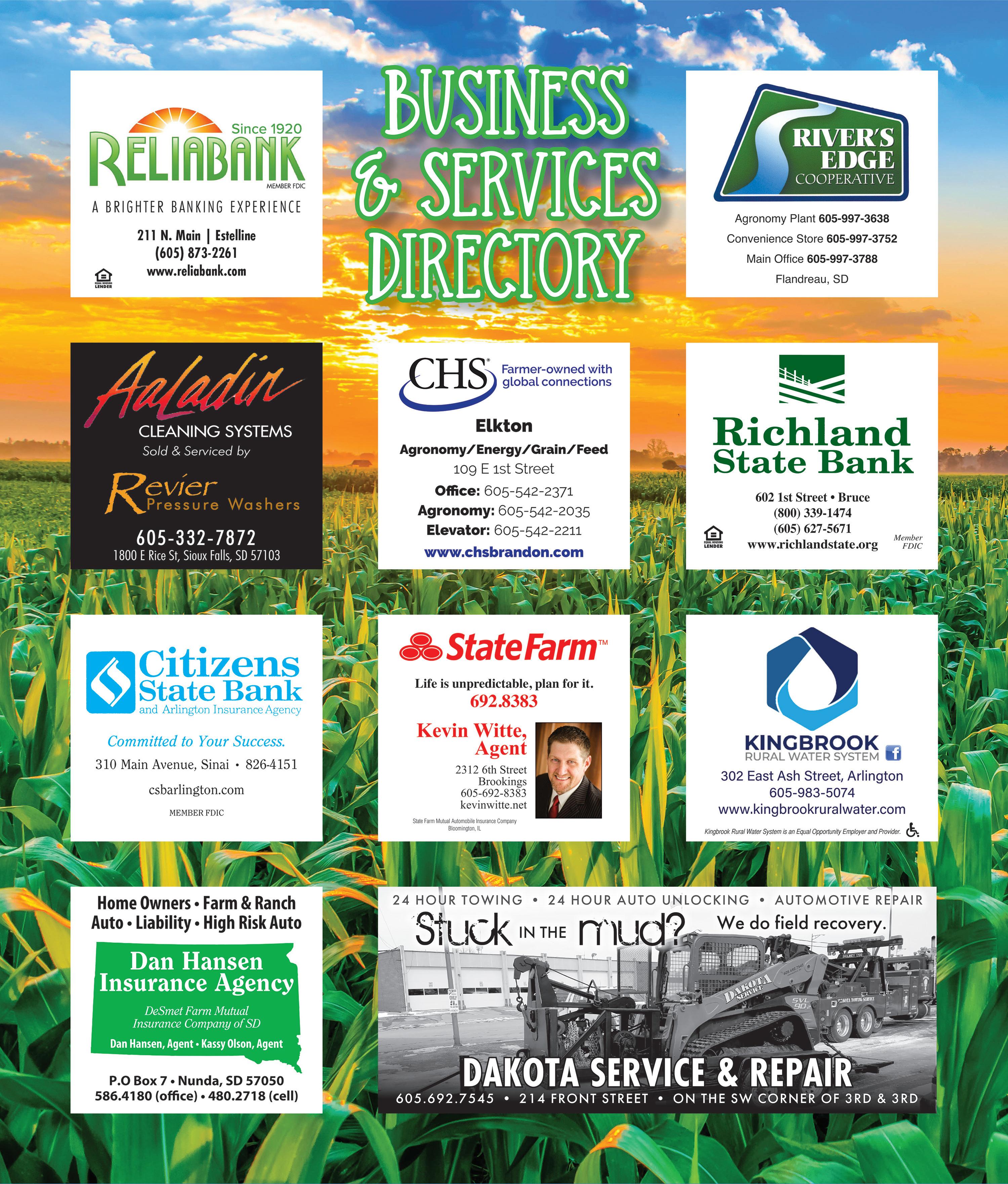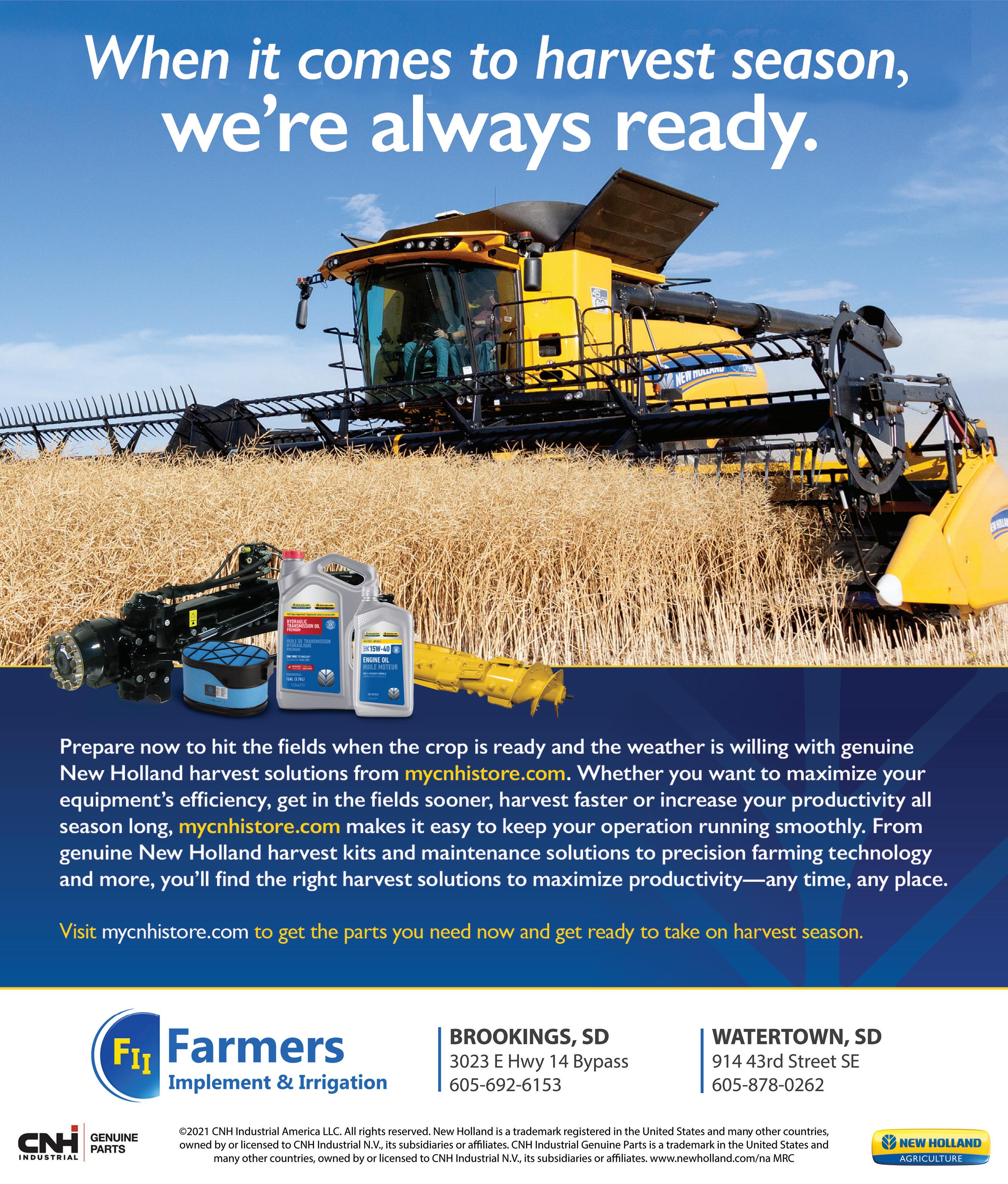








HURON – A Sept. 2 roundtable at the South Dakota State Fair – “Lower Food Prices, Keep Shelves Stocked: Common Sense Solutions to South Dakota’s Farm Labor Shortage” – brought producers and agriculture leaders together to discuss a growing problem and ways to fix it.
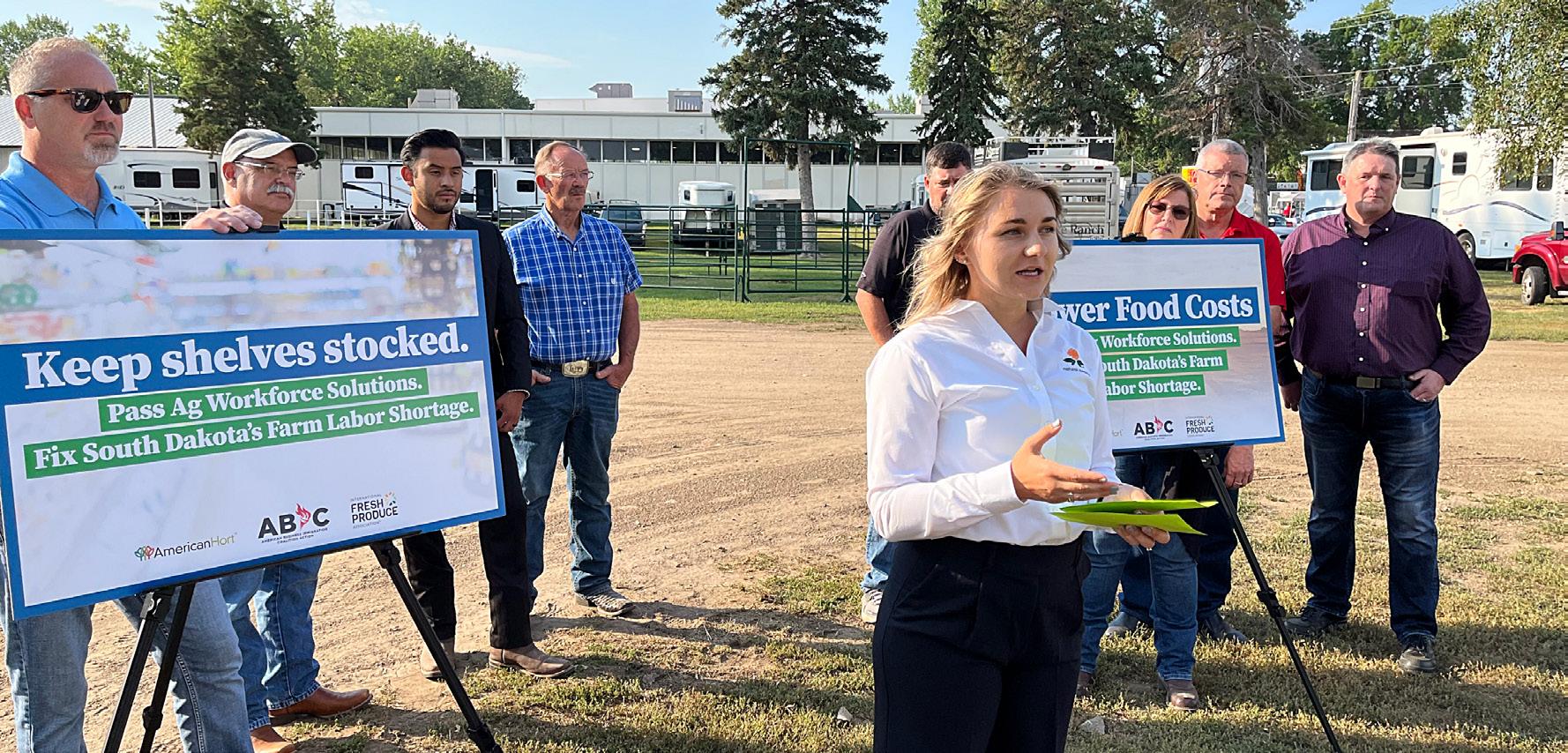
Participating in the event in the Pork Producers VIP Tent were the American Business Immigration Coalition Action, the South Dakota Dairy Producers, the South Dakota Farm Bureau, the Edge Dairy Cooperative, the South Dakota Pork Producers Council, AmericanHort, the South Dakota Association of Cooperatives, the National Council of Farmer Cooperatives and the International Fresh Produce Association.
With Senate negotiations ongoing, the event, featuring signs reading “Keep Shelves Stocked” and “Lower Food Prices,” called attention to the urgency of fixing South Dakota’s and the nation’s farm labor shortage by passing new Senate agriculture workforce solutions with a clear message: Food security is national security.
“Agricultural workforce modernization is a very important priority for the Farm Bureau,” said Scott VanderWal, president of the South Dakota Farm Bureau and vice president of the American Farm Bureau Federation. “Workplace shortages have been one of the greatest limiting factors for growth in U.S. agriculture. This is an urgent issue that needs a real solution and the American Farm Bureau implores the Senate to continue conversations and put together a bill that would work for everyone.”
Marv Post, board chair of the South Dakota Dairy Producers, said the need is urgent.
“This work is very labor-intensive and we need more workers. That will provide not only economic opportunities throughout the state and the nation, but will also give us food security – food on those shelves that we know was lacking and hurting us during so
much of the pandemic. More workers is something we’ve been asking for now, for many years. We need to have that labor security,” Post said.
Last week, the USDA predicted that food prices will continue to rise up to 9.5% in 2022 despite a decline in inflation, with grocery-store food predicted to rise up to 11%. Egg prices will continue to rise, to a growth range of up to 25.5%, with meat, poultry, and fish costs expected to rise up to 10.5%, and fruits and vegetables to rise up to 8%. Sugars, sweets, and nonalcoholic beverages also saw increases in forecasts.
According to the American Immigration Council, immigrants make up 7% of all workers in farming, fishing and forestry in South Dakota – and their labor is strongly linked to food prices. On the national level, Texas A&M International University recently released data from a new economic study on the link between stabilizing the agricultural workforce and decreasing inflation and consumer prices, showing that ensuring farmers have a stable, secure, reliable, and legal workforce is crucial to keeping America’s grocery shelves stocked, combating inflation, and lowering food prices (including milk, eggs, meat, and produce) for all domestic consumers.
Addressing workforce shortages facing farm employers and stabilizing the H-2A visa
application process is also crucial for enhancing our national food security by protecting domestic agriculture production. According to the USDA, next year, for the first time in U.S. history, the country will be importing more agricultural goods than we export.
“As you can hear from my accent, I’m not originally from South Dakota. I moved here from Ireland 18 years ago when South Dakota was seeking to grow its dairy industry, which wouldn’t have happened without us foreign folks,” said Michael Crinion, board member of Edge Dairy Cooperative. “Because of South Dakota’s forward thinking and business-friendly environment, there’s now a large dairy industry here with an economic impact of $5.2 billion a year. But it could be double that if we had the workers. Labor shortages in farm country hit crisis levels long ago and only continue to worsen. In dairy, it’s impossible to fill all positions with American citizens – that’s the truth.”
Crinion continued, “Farms just can’t function to their full potential without workers. A lack of them jeopardizes not only rural economies but also the nation’s food supply. It’s essential that we have access to a visa program for new workers. The House of Representatives recognized this when it passed the Farm Workforce Modernization Act (FWMA) last spring. We
now need the Senate to propose a solution. If the past few years have taught us anything, it’s that we’ve taken our safe, dependable food supply for granted. We can no longer afford to do that, which is why we’re asking the Senate for a solution.”
Alla Kureninova, operations manager of Natural Beauty and AmericanHort member, is a first-generation immigrant.
“I moved to Sioux Falls 10 years ago as a migrant worker at the same greenhouse I currently manage. It allowed me to earn extra money to support my family back in Ukraine, to learn English and experience the culture, safety and security that the U.S. has to offer. This is what H-2A programs are all about. They provide legal ways to enter the U.S. and earn money to support our families back home, or to support our own passions and dreams.”
Kureninova continued, “My family is still in Ukraine, where the Ukrainian people (in this time of war with Russia) have lost all control over their food independence and security. The simplest of goods are now a privilege and not a right. Meanwhile, here in the U.S., we’re already facing challenges that seem outside our control, like food price inflation. The USDA estimates that next year the U.S. will be a net importer of food, which will only drive food prices up more. Let’s not wait until we’ve lost that control of
our food supply completely like my home country did. For me as a mom, the most important thing is access to quality food produced right here in the U.S., which is why we need agricultural workforce reform.”
Greg Feenstra, vice president of the South Dakota Pork Producers Council, said the pork industry suffers from a labor shortage.
“Like the dairy industry, we can automate some things but not everything. We still need people. It’s critical that we increase our workforce. We have to work with our legislators and other commodity groups to find a solution that can propel us into the future,” Feenstra said.
ABIC Action Outreach Director James O’Neill said legislative action is important.
“The agricultural labor shortage is not a new problem but has grown in urgency lately. The Farm Workforce Modernization Act and the improvements on it that the Senate will negotiate are important for two reasons: This is a national security bill to make sure that food production stays in the country. It will also help us fight inflation,” O’Neill said.
“A new Texas A&M study shows that agricultural labor solutions help drive costs down at the grocery store. We can’t wait another year. We’d like the Senate to take action this year to fix the agricultural labor shortage,” he added.
Also speaking was ABIC Action Intermountain State Director Enrique Sanchez.
“A nation that cannot feed itself is not secure. We don’t want to rely on other countries to grow our food,” Sanchez said. “In 2019 and 2021, the House of Representatives passed the FWMA with bipartisan support. Now it’s time for the Senate to do its job. I’m a DACA recipient and the child of former farm workers. Due to his status, my father was unable to travel back to Mexico while working in the fields of California to be with my mother during my birth. But the opportunity of being here in the U.S. allowed me to attend school and then college. Farm workers want nothing more than to pursue the American dream.”
 By Lura roti For the SDSU Colleges of Agriculture, Food & Environmental Sciences and Education & Human Sciences
By Lura roti For the SDSU Colleges of Agriculture, Food & Environmental Sciences and Education & Human Sciences
BROOKINGS – Whether it’s on his family’s Parker farm, serving on numerous leadership teams, civic groups and agriculture organizations or during his time as South Dakota Secretary of Agriculture, Walt Bones III enjoys working with others toward a shared vision.
“To get things done it takes a group working together toward a common goal,” explained the 2022 Eminent Leader in Agriculture, Family and Community. “I come back to the lyrics of a Toby Keith song, “if you don’t know where you’re going, you might end up somewhere else.’”
In fact, it was the opportunity to work together with his family to continue the farming legacy that began when his great grandfather homesteaded the land in 1879 that motivated Bones to return to his family’s Turner County farm full-time after college in 1974.
“There was never any pressure from my folks to come back to the farm, but I wanted the opportunity to work with my family to carry on something that my great grandfather started,” Bones explained.
Throughout his long farming career, Bones has farmed with his dad, Walt Jr., brothers, Steve, Jim and John, sister Susie, brothers-in-law Lyle Van Hove and Jim Lammers, and nephews Dan Bones, Matt
Bones and Mike Van Hove.

“We are all looking to the future, and we are all looking at the common mission of the farm and enhancing opportunities for the next generation, knowing that our greatest strength was the variety of skill sets,” he said.
With the farm’s future in mind, the family worked to diversify their operation. To survive the Farm Crisis of the ’80s, they transitioned the farm’s focus from raising registered Hereford cattle, to a commercial cow/calf herd and custom feeding operation.
“My dad embedded in us the KISS principle - keep it simple stupid. We got back to the basics of what we knew how to do and do well. At the same time, we were always looking for opportunities,” Bones explained.
In the late 1990s the family partnered with other Turner County farm families to open the 1,650-head Turner County Dairy.

“This project was an opportunity to get more out of every acre. Now we were able to market some of our corn as silage through the dairy,” Bones explained.
Conservation has also been top of mind for Bones and his family. Beginning with their great-grandfather’s original Tree
Claim, the family continues to plant trees 143 years later. They also practice minimum tillage, implement water management projects for erosion control and rotational grazing purposes and plant wildlife food plots. Recognized in 2021 and 2022 for their conservation efforts, the family was nominated for the Leopold Award.
“We do these things because they are the right thing to do to enhance the stewardship of the amazing resources we have been entrusted with for the next generation,” Bones said.
When considering the next generation, for Bones stewardship extends beyond planting trees and grassland and soil health practices. “Sustainability has come to mean many things – but to me, it is more than just saving carbon credits. It is about giving the next generation the same opportunities we had,” Bones said.
Advocating for agriculture is among the many ways Bones has worked to provide opportunities to the next generation. With the support of his wife, Jan, and children, Christi Wilking, Lisa Stark and Ryan, Bones made time to serve in leadership positions on countless boards for civic and agriculture organizations throughout South Dakota and the region. Because of the farm’s proximity to Sioux Falls media outlets, on numerous occasions he also served as a gracious host.
“I’ve had lots of farmer friends say they wouldn’t want to stand in front of a camera. But who better to tell our story than
us,” Bones asked. “A favorite saying of mine is: ‘If you’re not at the table, you are probably on the menu.’”
Serving as South Dakota Secretary of Agriculture from 2011-2013, Bones worked to unite individuals around the State. Shortly after accepting Gov. Dennis Daugaard’s appointment, he organized a Key Leader Round Table Discussion, to bring stakeholders together from across the state for a strategic planning session to prioritize ways to enhance agriculture.
“I don’t know everything. One business paradigm is to surround yourself with people more talented than yourself. At the end of the day, we did things to impact each of those priorities,” Bones said.
Reflecting on the future of his family’s farm, and agriculture across South Dakota, Bones is optimistic.
Recognized for his leadership and volunteer efforts, Bones was named a 2022 Eminent Leader in Agriculture, Family and Community by South Dakota State University Colleges of Agriculture, Food & Environmental Sciences and Education & Human Sciences. He was recognized during an honoree banquet held at McCrory Gardens Education and Visitor’s Center on the campus of SDSU Sept. 16. During the banquet, portraits of the award recipients were unveiled. These portraits will be displayed in a virtual gallery at sdstate.edu/eminent-leaders-honorees. Bones’ portrait joins more than 350 portraits of Eminent Leaders.
Many of the vegetables we grow in our gardens produce seeds, which, if harvested and stored correctly, have the potential to grace us with free plants. And late summer is the perfect time to start collecting them.
A few notes: Make sure the plants from which you’re collecting seeds are heirloom, or open-pollinated, varieties. These are plants in their original forms whose seeds will produce plants with the same qualities as their parent.
Hybridized varieties, on the other hand, are created by breeding two or more different types to capture the best qualities of each. Attempting to grow seeds collected from hybrids will yield a harvest of disappointment, as the resulting plants will not have the expected attributes but rather carry the traits of only one of the parents – and there’s no way to know what that will be. For this reason, it’s best not to grow seeds from supermarket produce.
Many plants become cross-pollinated in the garden when pollinators, other insects, animals and wind transfer pollen from one plant to another. To ensure the seeds you collect will grow into plants that match their parent, different varieties of the same crop should be kept anywhere from 100 feet to a mile apart, depending on climate, weather and other variables. This is often impractical, if not impossible, in the home garden.
To avoid cross-pollination surprises, plant only one variety of the category of plants from which you plan to harvest seeds. If you want to save tomato seeds, for example, grow only one type of tomato in your garden.
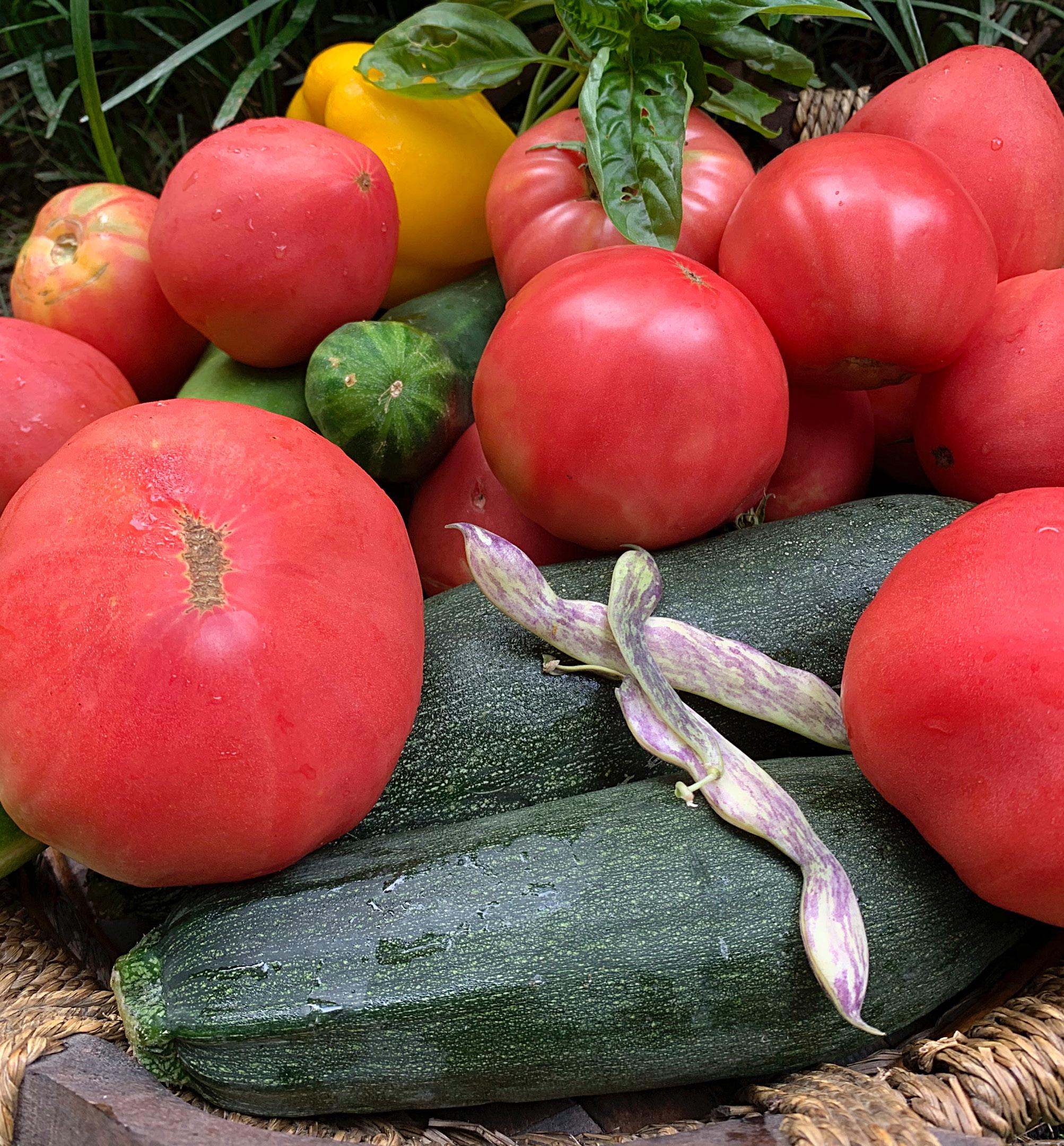
If that feels too limiting, go ahead and experiment, knowing that even if cross-pollinated, both parents are heirloom varieties you selected and planted. They’ll probably be fine even if they’re not what you expect.
Store all seeds in a cool, dry place in a covered glass jar or paper envelope away from ripening fruit, which would affect seed germination. The temporary addition of a silica gel packet to the jar will remove any remaining moisture, but take it out after a couple of days to avoid over-drying.
Here’s how to collect and save seeds from the most common homegrown crops.
At the end of the growing season, lettuce will bolt, or send up a flower stalk that will develop seed heads reminiscent of dandelion puffs. When the puffs are dry, remove the entire stem, place it into a paper bag, fold over the top and shake. The seeds will disengage from the flower and fall to the bottom of the bag.
Parsley is a biennial plant with a
two-year life cycle that produces only edible foliage in its first year and leaves and flowers in its second. Allow those flowers to remain on second-year plants until they become brown and brittle. Cut them off the plant and store them in a paper bag to dry completely for a couple of weeks. When you remove them from the bag, rub the flowers between your fingers to separate the seeds, then blow away the lightweight dry plant matter and discard.
Basil seeds are tiny, so separating them from the small flower petals and chaff can be tedious. When plants bolt at the end of the season, allow flowers to remain until they fade completely. Clip them off and place them in a mesh sieve or colander, then use your fingers to rub them against the bottom of the sieve.
These biennial plants produce seeds only in their second year, after a period of vernalization, or cold storage. In areas with cold winters, simply leave plants in the ground over winter.
In warm climates, you’ll have to create “winter” indoors: At the end of the first season, cut the foliage down to 2 inches, carefully dig up roots, and store them in a refrigerator or cool cellar over
winter. Replant them outdoors the following spring.
When the leaves of second-year beet plants turn brown, remove the seed stalk from the top of the plant and place it in a paper bag. Store in a cool, dry place for at least two weeks, then give the bag a good shake to separate the seeds. Pour them onto a plate, then blow on them to separate the chaff.
Allow second-year carrot flowers to dry on the plant, clip them off, and dry them further in a paper bag for a week or two. Shake the bag well and pour seeds out onto a plate, blow on them to separate the chaff.
Select the nicest-looking pepper from your healthiest plant and allow it to remain on the plant until it is overripe and wrinkled. Slice it in half and remove the seeds, discarding any that are discolored or otherwise undesirable. Spread seeds in a single layer on paper towels and allow them to dry in a warm spot away from direct sunlight. Toss the seeds occasionally to ensure even drying, which should take about a week.
Allow an eggplant to over-ripen on the plant until it becomes hard and
wrinkled, and loses its shine and color. Slice it open, remove its seeds and place them in a bowl of water. Agitate the water with your hands to separate seeds from any flesh that is adhered to them. Strain, then pat seeds dry with a towel and spread on a towel or screen to dry, tossing every day for up to a month until completely dry.
Because green beans produce an ongoing harvest throughout the season, enjoy the first flush or two, then leave developing pods on one plant until they are completely dried and brown. You’ll know they’re ready when they play like maracas. Cut the pods off the plant, place them in a cool, dark spot to dry further, then remove the seeds. Discard any that appear discolored or damaged, and spread the rest on a towel for a few days to harden.
There are two ways to save tomato seeds – the right way and the easy way. Full disclosure: I like it easy, and I’ve succeeded with the shortcut. Your results may vary.
Start by cutting a tomato in half, then squeeze out its seeds and pulp over a bowl.
Fermentation improves germination rates and kills some seed-borne pathogens that could sicken plants. To ferment seeds:
1. Place a cover slightly askew over the bowl and allow the seeds to sit in their juices undisturbed for three days.
2. Pour the bowl’s contents, which may be covered with a white film, into a larger container and add water equal to at least 3 times the seeds’ volume.
3. Agitate the water with your hand and pour off the liquid. You’ll notice that most of the seeds will have sunk to the bottom of the container; they are the viable seeds.
Any that float are duds, so pour them out with the juice, pulp and water. Repeat the rinsing process two more times.
To make sure pathogens are killed, soak seeds for 30 minutes in a 90% water, 10% bleach solution, then rinse very well. Spread seeds on a towel and allow to dry for about a week, tossing occasionally.
Or, you can simply allow the whole mess of seeds and pulp to dry on a plate in the open air for about a week, then scrape or pick off the seeds.
Allow your chosen fruit to become overgrown, wrinkled and dry on the plant. Remove it, slice it open and scoop out its seeds. If desired, follow the tomato fermentation process above. You’ll need to add a bit of water to the first step because there won’t be any juice or pulp in the container.

BROOKINGS – Bryan Jorgensen’s philosophy about the land upon which his family has built their lives and livelihoods for more than a century serves as a guide for the decisions he has made throughout his farming career.
“Our biggest legacy is the fact that we know this land is basically leased from our grandchildren. They have to be able to make a living on this soil, so it makes sense for us to take care of it and make it better for them,” said the 2022 Eminent Leader in Agriculture, Family and Community.
Sustaining the family farm for future generations matters to Jorgensen, because he and his wife, Brenda, value the opportunity they had to raise their family on the farm. The couple have three grown children, Nick, Kirsten McLaughlin and Reagan Nielsen, and nine grandchildren.
“I see no other way to raise a family,” Jorgensen said.
Located near Ideal, Jorgensen Land & Cattle is a diverse cow/calf and bull development operation that is the largest seedstock producer in the world. It includes a 12,000-acre no-till, diverse crop operation that produces feedstuffs, feed grains and certified seed. The family also operates an all-inclusive pheasant hunting
lodge.
“We have learned to incorporate all these different things on an acre of soil to make our farm sustainable, not only for us, but for our children and grandchildren,” said Jorgensen who operates the family farm in partnership with his son, Nick; brother, Greg; and nephew, Cody.
In addition to no-till practices, Jorgensen manages crop acres with a diverse crop rotation including wheat, oats, spring wheat, alfalfa, millet, grass hays, corn, milo, sorghum and more.
“The cattle give me an enormous opportunity to grow crops that are traditionally not marketed,” he said.
Bryan JorgensenServing as the farm’s chief agronomy officer, Jorgensen explained that focusing on soil health is key to all three integrated businesses. “Soil health management practices allow Mother Nature to take hold and do what she is really good at.”
Jorgensen became what he calls an “adamant no-tiller” not long after graduating from South Dakota State University in 1987.


“We quickly realized that having fewer trips across the field not only saved time and money, but we saw our soils become more conditioned to take in rain and retain moisture,” he said.


By 1991, the farm was 100% no-till. “That was the year our oldest son was born. There were times when we talked about tillage and he would ask, “dad, what is that?” All Nick has ever known is no-till,’” Jorgensen said.
Increasing diversity of plant species increases the soil’s organic matter and biodiversity, which Jorgensen explained dramatically decreases the farm’s need to apply synthetic fertilizers.
“Mother Nature never has one single thing or one single species growing in the soil,” Jorgensen said. “When you increase biological activity, you improve the quality of the soil.”
In 2015, Jorgensen Land & Cattle was recognized for its soil health and overall conservation efforts with the Leopold Award. Throughout his farming career, Jorgensen has given generously of his time to strengthen agriculture throughout South Dakota. In 2015, he became a founding member of the South Dakota Soil Health Coalition. Over the years his family has hosted many farm tours and Jorgensen has served in leadership roles for several other agriculture organizations including the South Dakota Crop Improvement Association. While serving as president, he was instrumental in saving SDSU’s oat breeding program.
Jorgensen credits the farm’s management structure and employee team
with his ability to spend time away. He explained that each week, the farm partners hold a meeting with the employee team to go through farm work and projects.
“My dad called it integrated resource management – pulling the right people together to accomplish a job,” Jorgensen explained.
Jorgensen was named a 2022 Eminent Leader in Agriculture, Family and Community by South Dakota State University Colleges of Agriculture, Food & Environmental Sciences and Education & Human Sciences. He was recognized during an honoree banquet held at McCrory Gardens Education and Visitor’s Center on the campus of SDSU Sept. 16. During the banquet, portraits of the award recipients were unveiled. These portraits will be displayed in a virtual gallery at sdstate.edu/eminent-leaders-honorees.
Jorgensen’s portrait joins more than 350 portraits of Eminent Leaders – including the portraits of his grandfather, Martin Jorgensen Sr. (1965) and his dad, Martin Jorgensen Jr. (1984).
“Legacy has always motivated me. Grandpa started the farm. Dad built the farm. I didn’t want to be the one to drive it down the tubes,” Jorgensen said.
As he reflects on the next generation he now partners with – his son and nephew – he said he is confident the farm’s legacy is in good hands.

BROOKINGS – Over the last decade, agriculture research has become more and more advanced – in large part because of unmanned aerial vehicles, otherwise known as drones. At South Dakota State University, drones have become integrated into a variety of research activities but have arguably been the most impactful in agricultural research.
Maitiniyazi Maimaitijiang, an assistant professor in the Department of Geography and Geospatial Sciences, has been working in conjunction with other faculty members to conduct drone-related ag research over the last few years, specifically in relation to early diagnosis of crop water stress, nutrient deficiency, crop health and diseases – major threats to food security and crop yield estimations.
“We are trying to develop robust, rapid, accurate and operational solutions and tools to detect and diagnose crop water stress, nutrient deficiency, and crop health and diseases – especially early detection,” Maimaitijiang said. “We are trying to develop some new algorithms using satellites, using drones, using artificial intelligence, using different types of information, to detect this in advance before the symptoms become visible. Because once it becomes visible, the control could be too late.”
Once the disease becomes visible on the leaf level, even spray may become useless, Maimaitijiang noted.
Previously, the traditional method of detecting crop disease was laborious and time consuming – requiring hours and hours of tediously collecting data over acres and acres of fields. Drone technology has created a more efficient – and reliable – method for detecting crop disease. While still not a perfect science, deep learning has made breakthroughs in the field of digital image processing, which combined with drone technology – has propelled ag research forward in recent years.
Maimaitijiang and Shahid Khan, a doctoral student, have spent the last few months collecting data using drones to further their research. Below is a synopsis of the ins and outs of
becoming a drone pilot and a rundown of their research process.
Maimaitijiang got his initial start in drones in 2015 at Saint Louis University, where he earned his Ph.D.
“I worked in the remote sensing lab there,” Maimaitijiang said. “Most of my work was drone-related stuff.”
Between 2015 and 2022, the drone industry increased substantially. In 2020, the commercial drone market was pegged at $13.44 billion, and is expected to double every two years through 2028.
The SDSU Department of Geography and Geospatial Sciences, the de facto drone experts on campus, responded to the industry’s growth and began offering drone instruction in 2017. Now, the department
offers a certificate in unmanned aircraft systems, which requires 12 credit hours, and will offer an 18-credit hour minor in unmanned aircraft systems –tentatively set to start in fall 2023.
The primary class for drone instruction at SDSU is “GEOG 270, Introduction to Small Unmanned Aircraft Systems.” GEOG 270 is somewhat of a “melting pot” course, with students from aviation, agriculture, precision agriculture and construction management programs, among others, all coming together to learn how to fly and operate drones. Another key course GEOG 483/583 UAS Remote Sensing trains students with multiple tools and skills for drone image processing which generates useable maps and products.
After taking that class, students have the knowledge to
pass the Federal Aviation Administration’s Part 107 Remote Pilot Certificate – a requirement for commercial operation of a drone. All researchers who incorporate drones into their work must pass the FAA’s test.
Khan remembers being a little nervous before taking his FAA certification test. He had studied two to three hours a day for about a week but still wasn’t convinced he was going to pass.
“I thought it might be hard and that I might fail,” Khan said. “But I went there, took the test and it went very well. I passed and became certified.”
After getting his FAA license, Khan was able to start flying drones. But rather than fly the commercial-grade drones used during the data collection, Maimaitijiang instructed Khan to learn to fly a much more challenging drone: a DEERC D20 – a
$50 “mini” drone designed for kids.
“That one is actually not easy to fly,” Maimaitijiang said. “It does not have GPS or a barometer so there is no automatic hovering mode. It can be very unstable.”
Using these “hobby” drones, Khan and other doctoral students prepare to fly the commercial grade drones. After 20 hours of training, in which they practice different landings, take offs and flight paths, the students are ready for the “big leagues.”
“Once you get used to that one, it is much easier to fly these bigger (drones),” Khan said.
Flying the commercial-grade drones are surprisingly pretty straight forward, Maimaitijiang said.
“The main reason is because most of these commercial drones have very good GPS and barometer devices,” Maimaitijiang explained. “When you take off, it can automatically adjust its position and hover there, even when you take your hands off the controls.”
Drones can also be programmed to go on autonomous missions. Prior to heading out to a research field, Maimaitijiang and his students will program in a flight path for the drone.
“Prior to the flight, you need to do the mission planning,” Maimaitijiang said. “You need program in the flight height, flight speed, flight paths – all those parameters you need to define preflight and then send this information to the drone.”
Once at the field, the drone will fly itself and Maimaitijiang can focus on the data being collected. Due to FAA rules, there still needs to be someone holding the drone’s controller, however.
“We upload the mission and with just one click, it will automatically take off, collect the data and then come back,” Maimaitijiang explained.
Some drones can fly for around two hours, and others can fly for 30 minutes – it all depends on the type of drones (fixed wing or rotary drone), and also the payload and amount of equipment it is carrying. They will usually cover between 10

and 50 acres during a flight.
“That’s the main limitations of these drones,” Khan said. “You cannot cover too much area using these batteries.”
There are some restrictions that drone pilots must keep in mind. Drones are not supposed to fly over 400 feet high and, for many flight situations, requires approval from the local airport if the flight area is near. Pilots also need to have emergency plans, insurance and approval from landowners on hand.
Most drones cannot be flown while it’s raining but they can be flown during the winter, as long as it’s not too cold or too windy. For rotary drones, wind speeds often need be under 15 mph and cannot have gusts over 20 mph for safety – a challenge in South Dakota. These types of drones can’t handle extreme heat, either. For data to be collected accurately, conditions need to be favorable and very mild.
“That’s why when you’re taking the FAA test for certification, there’s a lot of weather-related questions because they really want you to be aware of the clouds, wind and everything else,” Khan said. “One thing that they specifically focus on is you need to plan accordingly to the weather. So before planning for flight at specific locations, you need to check the weather.”
While drones are absolutely necessary for data collection, they are simply a vehicle for the more important and expensive piece of research equipment: the sensors. While high-end drones needed for the type of research Maimaitijiang does can be between $5,000 and $15,000, the infrared sensors needed to collect the data can be five to 10 times more expensive.
“Certain sensors are compatible with certain drones, while others are not. The drone is just the vehicle to carry those sensors,” Khan said. “They are really like the backbone of the system.”
The hyperspectral sensors are really just very high-end cameras that collect the data in different ranges of electromagnetic spectrums, Khan said.
When the weather cooperates enough to fly the drone, Maimaitijiang will travel to various farms and research fields to collect data. At the fields, he will fly commercial-grade drones at various heights, which collect data using the high-performance sensors.
“When it flies over a wheat field – for example – it collects images,” Maimaitijiang said. “We use these images – now labeled as data – to train artificial intelligence machine learning models. It can then automatically detect if there is disease.”
Using this information, farmers would be able to apply a specific amount of fungicide resistance control chemical spray at specific locations (in a more efficient manner) to rid their field of disease, Maimaitijiang noted.
“We can use drone techniques to automatically get growth status, canopy height, crop health and disease level, nutrients and water stress level and predict the final yield,” Maimaitijiang said. “We just take that data (that was collected from a drone pass) and build some data drive artificial intelligence models. This model uses the data to detect those different parameters.”
The collected data from the drones is beneficial for both farmers and breeders as they are able to accelerate the plant phenotype breeding process with high efficiency, Maimaitijiang said.
Khan, who has previously had a research article published about crop yield predictions using remote sensing data from satellites, is doing similar work now, except instead of satellites, he is using drones.
“Currently, what we are doing is flying drones over different crops at different stages in the growing cycle – like early stage, into the growing stage and then at maturity,” Khan said. “We fly 10-12 times each cropping season.”
The collected data from the crops is then correlated with crop yield and

other parameters, Khan said. His specific research work is looking to accurately estimate crop yield prior to harvest.
The overarching goal of Khan’s research is to make crop yields more efficient for farmers.
“Another thing is, before the harvest, (farmers) can see what’s going on in their crops,” Khan said. “So, if they need to do some intervention or if they need to make some decisions, like increasing fertilizers or something else, it can help them in the decision-making process to increase yield or control disease.”
In the future, Khan wants to continue researching crop characteristics through drones while venturing into more disease monitoring.He is also looking to work with researchers at tribal colleges to seek out invasive species using drone technology.
As drones continue to filter more and more into the mainstream, breakthroughs will continue to happen, Maimaitijiang theorized.
“Drones have made research a lot easier,” Maimaitijiang said. “Integrated with artificial intelligence, in plant breeding, precision ag – drones are basically revolutionizing the crop scouting in those fields.”
– From SDSU Marketing & CommunicationsTroy Boomsma says if someone told him that he would lose a son in a tractor rollover, he would say that could never happen.
But it did.
And when the Boomsma family lost 7-year-old Jaxon to a farm accident on his grandparents’ farm Easter weekend 2017, Troy Boomsma made it his mission to promote farm safety. His hope is, other families will not experience the same tragedy.
“When you go through a tragic accident like this, it changes your family. It changes who you are,” Troy explained.
Troy and his wife both grew up on farms. And like so many farmkids, they valued their childhood experiences and made an effort to ensure their children were able to spend as much time as possible on their grandparents’ farms.
“Growing up on a farm, you learn a work ethic, accountability and character – it all helped us become who we are,” Troy said. “The challenge I see is while the farm is a great place to raise a family, it is also a dangerous place. All I ask when I meet with farmers, is just pause for a moment and consider safety before you proceed.”
To encourage farm families to consider safety, Troy, his sister Mary Boomsma, and Jaxon’s siblings, Jaiden, Callie and Carter, created a children’s book for families to read together.

The book follows Jaxon as he explores his grandparent’s farm. Each page highlights aspects of the farm Jaxon loved, and shares safety tips: “I love the Green tractors, but remember, tractors are really big and sometimes the farmer can’t see what is around him. It is very important that we stay away from tractors and know where they are at all times!”
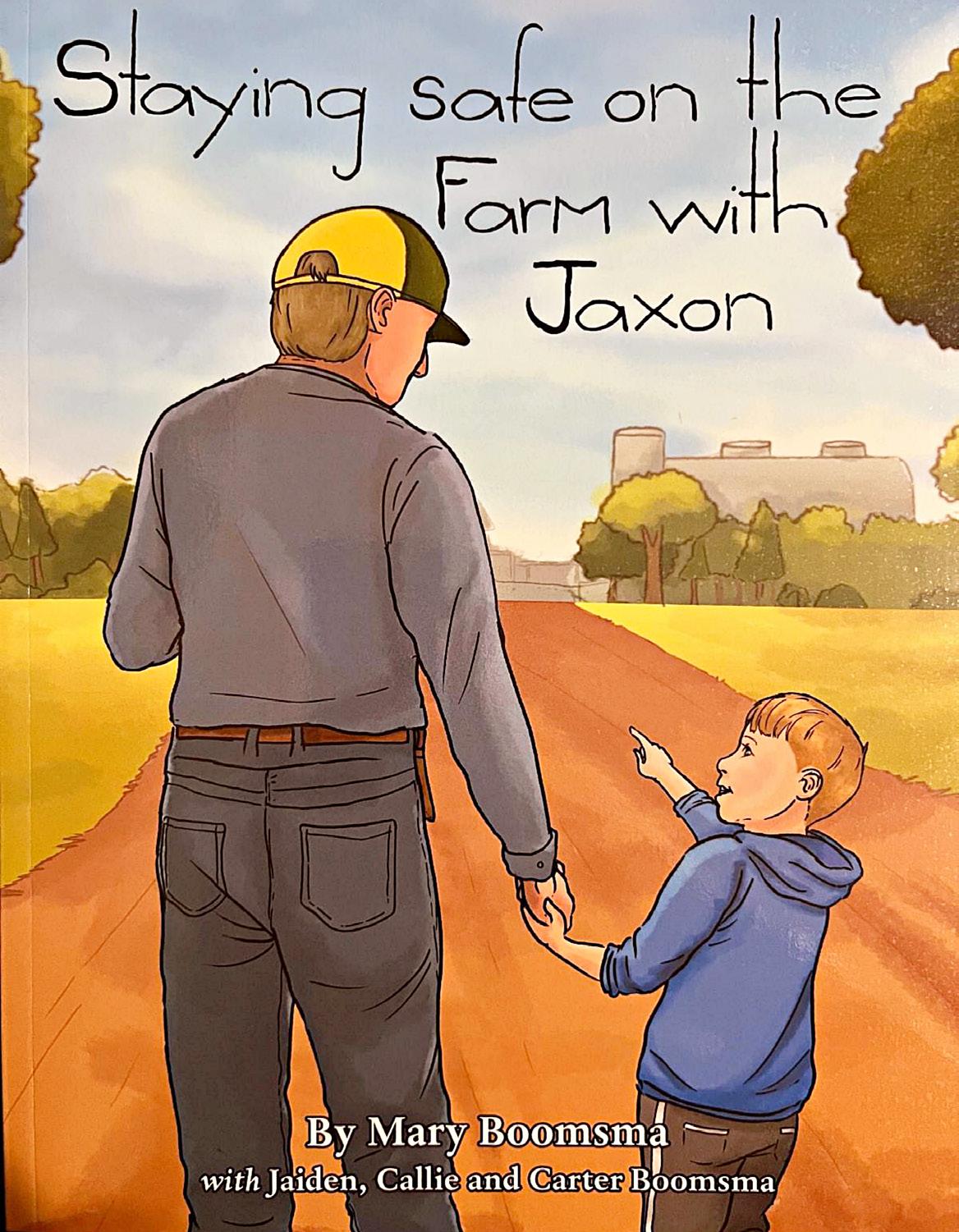
“We realized a lot of farm families are so used to working on the farm, they do not think about how hazardous it can be,” explained Jaxon’s oldest sister, Jaiden.
When Jaiden learned about the children’s book her dad and aunt were working on, she suggested the illustrations be based on actual photos from the family farm. “Jaxon loved the farm. For a school project he wrote, “when I am 60, I want to be a farmer,” she said.
Jaiden is studying business
and marketing at South Dakota State University. “The book is aimed at younger children, but as adults read it to them, they get to see the safety aspects as well.”
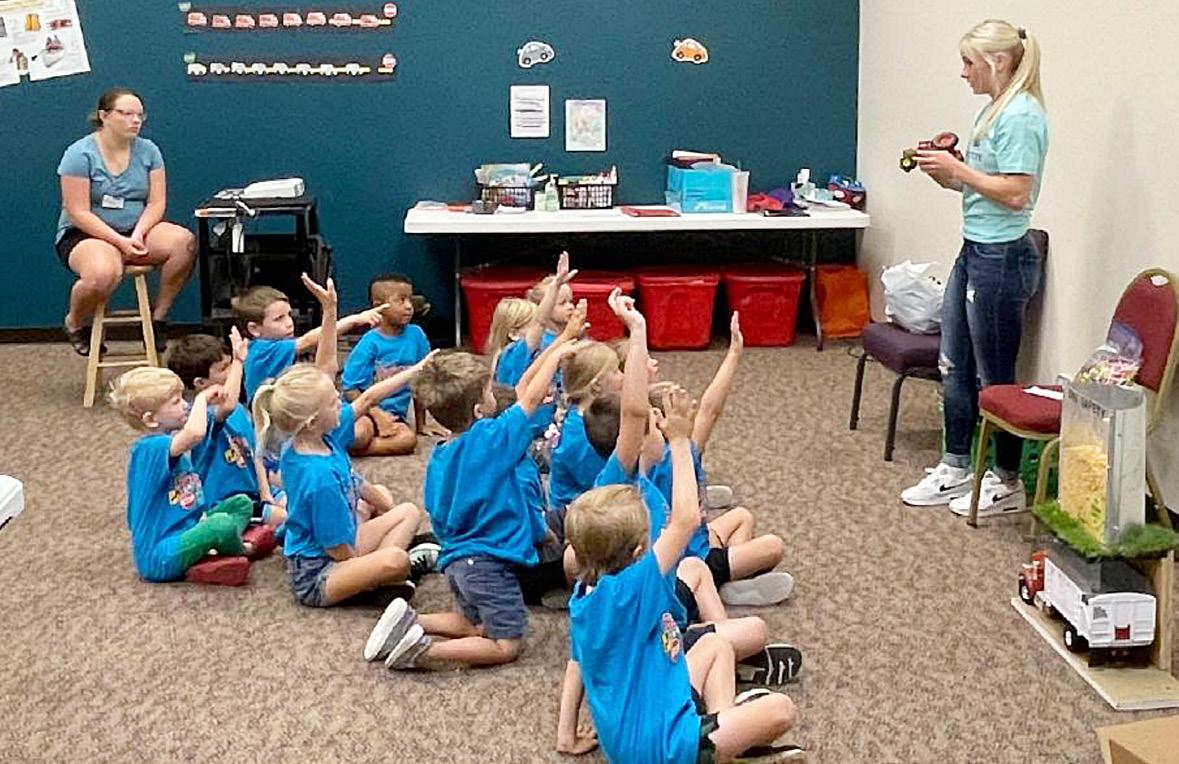
Jaiden has joined her dad in advocating for farm safety. In addition to the Facebook page her mom and the JLB Committee manage, she expanded the farm safety social media messaging to Instagram and TikTok. JLB is short for Jaxon’s full name: Jaxon Liam Boomsma.
“I thought I could be a spokesperson for people my age,” explained Jaiden, who recently began giving farm safety presentations to school-age children. “It is emotional, and it will always be, but seeing how many people take in the farm facts and apply them to real life helps me realize we are helping.”
After losing Jaxon, Troy began researching farm accidents. “What hit me, is a child dies in an accident every three days. The leading causes are side-by-sides and tractors. Twenty-five percent of those are tractor rollovers.”
Through his work as a territory manager for Pioneer Seed,
Troy meets with farmers daily and immediately became aware of the fact that many other farm families were impacted by similar tragedies. “It is amazing the amount of people I have talked with who have lost children to farm accidents. It helps to learn how they got through it.”
For Troy, sharing his family’s story and promoting farm safety is healing. “I get it, for some, talking about it is really hard. For me, it helps. Hopefully by sharing our story, we can help someone.”
To learn more about the Boomsma farm safety advoca-
cy work or to order a copy of Staying safe on the Farm with Jaxon, visit Jaxon’s memorial Facebook page: Jaxon L. Boomsma Keep his Smile Alive.
Throughout 2022, South Dakota Farmers Union will distribute copies of Staying Safe on the Farm with Jaxon, to youth and families as part of their effort to provide farm safety education.
“We are grateful to the Boomsma family for having the courage to share their story to help keep other families safe,” said Karla Hofhenke, executive director of South Dakota
Farmers Union.
Farm safety is a focus of South Dakota Farmers Union educational programming. In 2018 the state’s largest agriculture organization designed a Farm Safety Trailer to provide youth with an interactive and fun way to learn about farm safety.
Farmers Union puts thousands of miles on the trailer, taking it to schools, fairs, community, 4-H and FFA events across the state explained Rocky Forman, membership coordinator.
“Kids learn best by doing,” Forman says. “So, we made sure each safety lesson exhibited in this trailer engages youth in a hands-on activity.”
For example, youth can try on a safety harness while learning about grain bin safety; drive an ATV simulator to learn how to safely drive an ATV and through the 3-D model farm, they can learn about high-risk areas of the farm and how to be safe.
To learn more about the work of South Dakota Farmers Union
support farm and ranch families and their rural communities, visit www.sdfu.org.
It is difficult to protect yourself from a hazard you don’t recognize. On the farm, electrocution claims the lives of approximately 62 agricultural workers each year (www.electrocution.com), people die in fires caused by faulty electrical systems, people are injured through electrical shocks and burns, and property is damaged or destroyed due to incidents involving electricity.
Overhead power lines are a common source for on-farm electrocution fatalities. Lines may have been installed without insulation or the insulation may have worn off due to exposure from weather. The safest approach to working around overhead power lines is to assume that they are bare.
Unlike birds, that can sit on a power line without any consequence, when humans touch overhead lines, they are in contact with the ground at the same time. This gives the electricity a channel to flow through, which results in electrocution.
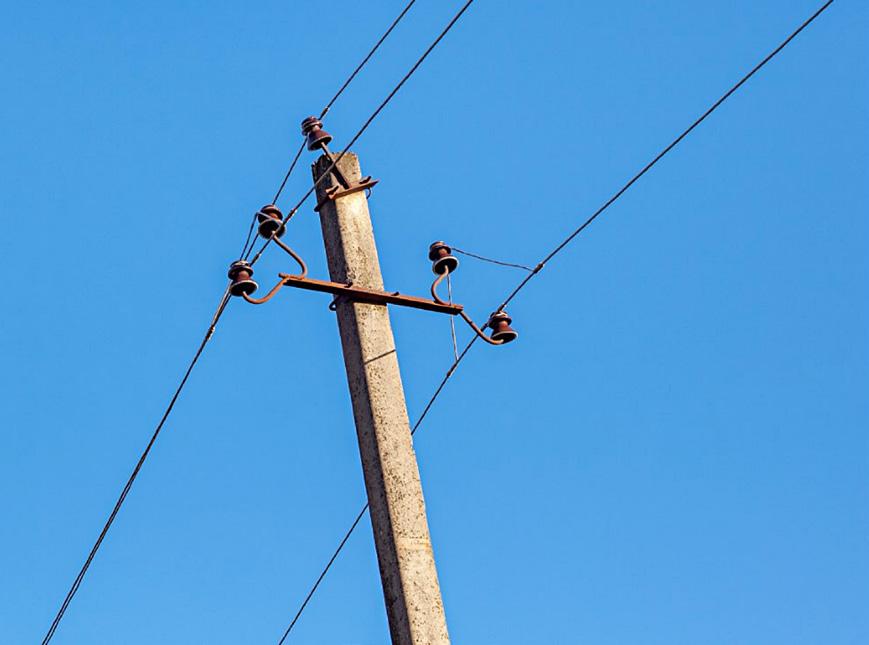
Other common electrocution hazards on the farm include degradation of electrical wire insulation from rodents, weathering, etc.; improper wiring, corrosion of electrical connections, moving irrigation pipes, using electricity in dusty conditions found inside agricultural buildings, and more.
Farm equipment that’s often involved in overhead power line contact includes tractors with frontend loaders, portable grain augers and elevators, dump trucks, feed trucks, irrigation pipes, equipment with antennas, and folding implements.
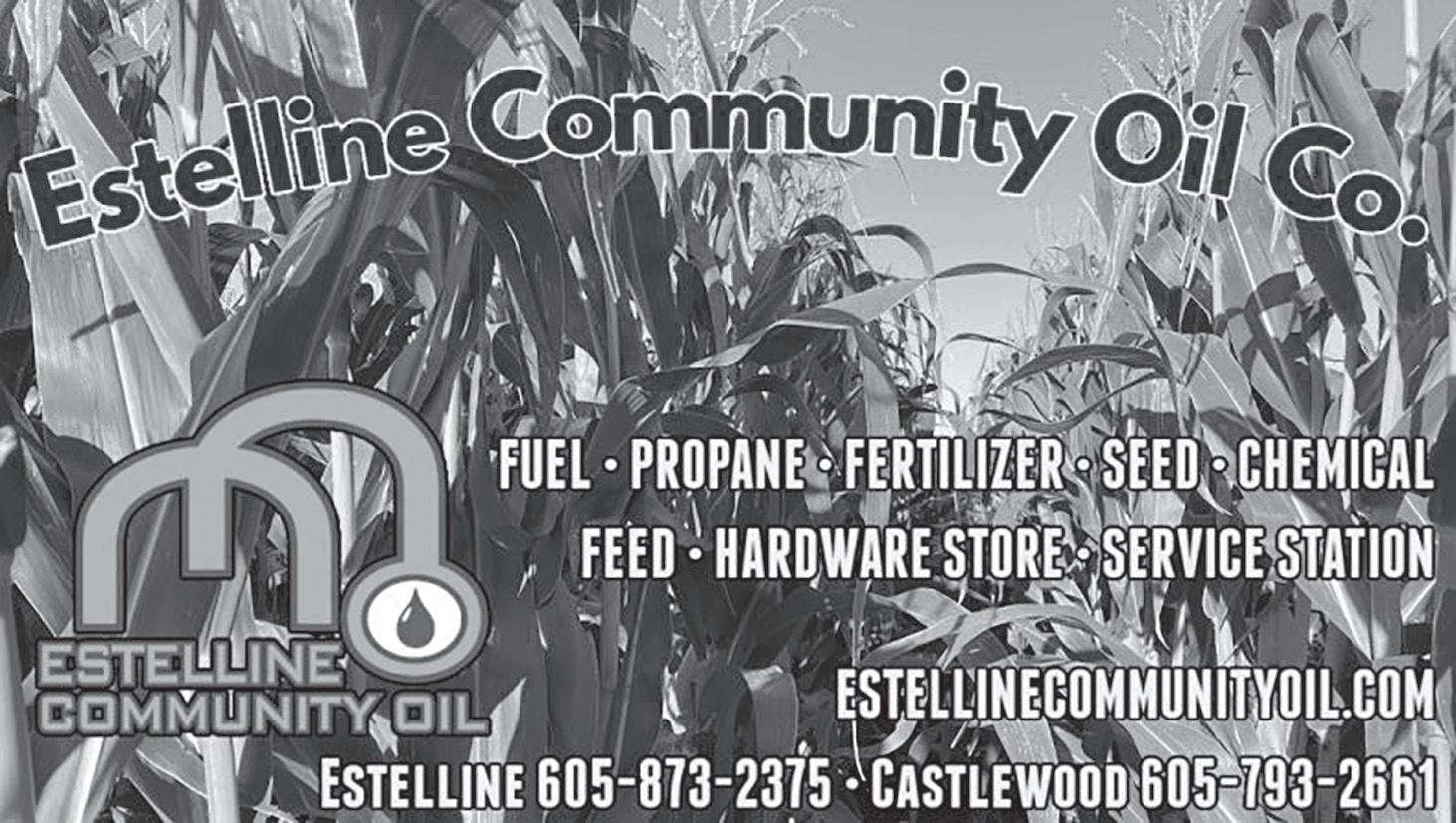
When using dump trucks, the operator should be aware of the location of overhead power lines before raising the bed and should not move the truck or trailer while the bed is in the raised position. Areas with overhead lines should be clearly marked. Typically, if a raised bed contacts a power line, the operator will not be at risk as long as they remain inside the vehicle, because the tires provide insulation.
However, if anyone standing on the ground touches the dump truck or trailer while it’s in contact with overhead lines, that person could be electrocuted.
A loader tractor or telescopic load may be used to handle hay. Because booms on these types of equipment may reach as high as overhead power lines, hay should not be stored under power lines.
Around grain bins, the National Electrical Safety Code requires power lines to be at least 18 feet above the bin’s highest point of any bin constructed since 1992. Whenever a new grain bin is installed, a licensed electrician should be consulted to assist with placing electrical service lines. Lines may also be buried to reduce electrocution risk. Local utility officials can also help evaluate line height issues on the farm site.
When moving equipment beneath a power line, clearance should be at least 10 feet between the power line and the highest point on the equipment. Keep in mind that implements such as a fold-up planter will be taller when folded up than when they’re used in the field.
Everyone involved in planting and harvest activities must be trained to recognize potential electrocution hazards. Clearly identify any area where there are electrocution hazards related to overhead power lines when equipment is used or moved.
Electrocution hazards related to standby generators include using the transfer switch to remove the farm’s electrical system from the power company’s utility lines. This switch prevents electricity generated by a farm operation’s emergency power system from entering the power company’s utility lines and protects from electrocution those power company workers who service lines during an outage. The switch also protects the generator when power is restored.
Always use the transfer switch when your standby generator is in operation. Make sure all workers know the location of the transfer switch.
HURON – The Oakwood Lakes Watershed Conservation Implementation Strategy Project will soon enter its second year in northwest Brookings County. The project serves farmers, ranchers and the community by improving land and water quality. This three-year project is one of 17 selected in fiscal year 2021 and federally-funded through the Natural Resources Conservation Service’s conservation programs in the 2018 Farm Bill.
The purpose of this project is to help producers install a number of practices that will result in the reduction of sediment, nutrients and pesticides entering surface waters within the watershed and will be implemented by the Brookings Conservation District and East Dakota Water Development District in collaboration with farmers, ranchers and landowners within the project area who are eligible to apply for financial assistance. While applications are accepted year-round, the review date for FY22 applications is Dec. 2.
The NRCS conservation specialists and partners coordinate projects throughout the state. Through collectively focusing expertise and resources on the highest priority resource concerns in the highest priority areas, CIS projects can yield impressive returns. The Oakwood Lakes project partners with producers, the Brookings CD, and EDWDD to improve water quality and decrease soil loss from erosion.
Project sponsors identified excess nutrients, sediment and pesticides as resource concerns and developed this CIS project to address the situation.
“By having agricultural producers voluntarily implement practices that target excess nutrients, sediment and pesticides in surface waters, we hope to see a verifiable reduction of those three resource concerns in the watershed by the end of the project. The ultimate goal is cleaner water for everyone in the watershed,” said Jeremy Sova, district conservationist, Brookings Field Office.
To apply to be a part of this project, find and contact your local NRCS Service Center at www.bit.ly/contactnrcssd, or contact Sova at jeremy.sova@usda.gov or 605692-8003, Ext. 3. For more information on the CIS in South Dakota, or if you have ideas for a project, visit www.bit.ly/ SDNRCS-CIS, or contact Brandon Kotke, acting assistant state conservationist for programs, at brandon.kotke@usda. gov or 605-352-1203.
 – From Natural Resources Conservation Service
– From Natural Resources Conservation Service
NEW YORK (AP) – Bill Gates says the global hunger crisis is so immense that food aid cannot fully address the problem. What’s also needed, Gates argues, are the kinds of innovations in farming technology that he has long funded to try to reverse the crisis documented in a report released Tuesday by The Bill and Melinda Gates Foundation.
Gates points, in particular, to a breakthrough he calls “magic seeds,” crops engineered to adapt to climate change and resist agricultural pests. The Gates Foundation on Tuesday also released a map that models how climate change will likely affect growing conditions for crops in various countries to highlight the urgent need for action.
In assigning technology a pre-eminent role in addressing the world’s food crisis, Gates puts himself at odds with critics who say his ideas conflict with worldwide efforts to protect the environment. They note that such seeds generally need pesticides and fossil fuel-based fertilizers to grow.
Critics also contend that Gates’ approach doesn’t address the urgency of the crisis. Developing “magic seeds” takes years and won’t immediately deliver relief to countries currently enduring widespread suffering because they rely on food imports or are experiencing historic droughts.
It’s a debate that could intensify international pressure to meet the shared goals for global prosperity and peace, known as the U.N. Sustainable Development Goals, ahead of a 2030 deadline. The 17 goals include ending poverty and hunger, battling climate change, providing access to clean water, working toward gender equality and reducing economic inequality.
“It’s pretty bleak relative to our hopes for 2030,” Gates, 66, said in an interview with The Associated Press. He added,

though, “I’m optimistic that we can get back on track.”
Gates pointed to the war in Ukraine and the pandemic as the main causes for the worsening hunger crisis. But his message to other donors and world leaders convening for the U.N. General Assembly this September is that food aid won’t be enough.
“It’s good that people want to prevent their fellow human beings from starving when conflicts like Ukraine interrupt the food supply,” Gates writes in the new report. But the real problem, he says, is that many food insecure countries don’t produce enough of their own food – a problem sure to be exacerbated by the consequences of climate change.
“Temperature keeps going up,” Gates said. “There is no way, without innovation, to come even close to feeding Africa. I mean, it just doesn’t work.”
As he has for more than 15 years, Gates called for investment in agricultural research, highlighting corn seeds that thrive at higher temperatures and in drier conditions than other varieties. Those seeds were developed under a program of the African Agricultural Technology Foundation to which the foundation has given $131 million since 2008.
Since then, the Gates Foundation has
spent $1.5 billion on grants focused on agriculture in Africa, according to Candid, a nonprofit that researches philanthropic giving. The Bill and Melinda Gates Foundation is by some measures the largest private foundation in the world and is best known for its work on global health, including vaccines. It began in its current form in 2000, after Gates left his CEO position at Microsoft, the tech giant he co-founded. Forbes estimates his net worth to be around $129 billion.
The foundation’s spending on agricultural development is why Gates’ view on how countries should respond to food insecurity has taken on heightened importance in a year when a record 345 million people around the world are acutely hungry. The World Food Program said in July that tally represents an increase of 25% from before Russia invaded Ukraine in February and a 150% jump from before the pandemic struck in the spring of 2020.
In Ghana, field trials for four varieties of modified seeds began in 2013. But only this past summer has one been approved for commercialization, said Joeva Rock of the University of Cambridge. Activists there, she said, have asked whether those resources could have been better spent elsewhere.
“What would happen if those went into increasing funds to the national research centers in Ghana, to building roads, to building storage, to building silos or helping to build markets?” said Rock, who has written a book about food sovereignty in the country.
When asked, Gates acknowledged the importance of infrastructure like roads and other transportation systems. “If you want your inputs like fertilizer to come in, if you want your output to go out, it’s just too expensive in Africa without that infrastructure,” he said, adding that building and maintaining roads is highly expensive.
Some researchers question the wisdom of pursuing the fundamental premise that
Gates has embraced: Increasing agricultural production through the use of modified seeds along with fertilizers and pesticides. They point to the environmental footprint of industrial agriculture, including the use of fossil fuel-based fertilizers, the degradation of soil quality and the diminishing of biodiversity.
Alternatives could include agroecological interventions, like developing locally managed seed banks, composting systems to promote soil health and pesticide interventions that don’t rely on chemicals, experts said. Over time, those approaches can reduce the need for food aid and build more resilient farming systems, according to Rachel Bezner Kerr, a professor of global development at Cornell University.
Kerr, a lead author of the food chapter of the latest report from the International Panel on Climate Change, said that while the panel doesn’t make recommendations, “overall, the kind of focus on a few technologies and reliance on fossil fuel-based inputs isn’t in line with ecosystem-based adaptation” or a biodiverse future.
Mark Suzman, CEO of the Gates Foundation, defends its approach warning that limiting access to fertilizers means farmers cannot increase their yields.
“Fertilizer is necessary. You simply cannot meet the overall productivity gains without it,” Suzman said, speaking on a call with reporters.
In his interview with the AP, Gates himself dismissed criticisms of the foundation’s emphasis on modified seeds.
“If there’s some non-innovation solution, you know, like singing ‘Kumbaya,’ I’ll put money behind it,” Gates said. “But if you don’t have those seeds, the numbers just don’t work.” He added, “If somebody says we’re ignoring some solution, I don’t think they’re looking at what we’re doing.”
Another project the foundation has funded is the development of computer models that try to measure crop loss caused by disease or pests.
Continued from page 11
If your tractor contacts a power line, stay on the tractor. Immediately ask someone to contact the local utility company to resolve the danger. In the event that there’s a need to leave the equipment (i.e. an electrical fire), jump as far away from the equipment as possible. Do not allow any part of your body to touch the equipment and the ground at the same time. Hop with your feet together to prevent electrical conduction through your legs.
Once you’re away from the equipment, never attempt to get back on it or touch it. It’s not unusual for an operator to dismount the equipment and, realizing that they’re OK, to get back on the equipment and be electrocuted in the process.
Prevention is the best way to avoid emergencies. Respect electricity and take
every precaution to avoid contact with overhead power lines.
Four important electrical safety devices and features to be aware of are fuses and circuit breakers, GFCIs, grounding, and polarization. Fuses and circuit breakers help protect an electrical system from current overload, but they don’t protect people from electrical shock.
A ground wire provides an alternate path for electricity to flow back to ground potential if an electrical short occurs. Never destroy or cut off a grounding prong on a plug to make it fit into a socket or extension cord that doesn’t accommodate the prong. If you work with equipment that doesn’t have a grounding wire, consider rewiring the device to accommodate this feature.
GFCIs – Ground Fault Circuit Interrupter – monitors current flow to an electrical device, comparing it to the
amount of current flowing back. If there’s a difference between the two, which indicates a malfunction, the GFCI stops the current flow before harmful amounts of current can flow through an individual.
Polarization refers to plugs and outlets that have two different-sized prongs or slots. This helps protect you from accidental contact with an energized socket.
Additional safety practices around electrical power include:
1. Choose a route on your farm site that avoids potential contact with overhead power lines.
2. Never touch a power line.
3. Contact your local power company if an incident occurs.
4. Never use ladders around power lines.
5. Contact your power company to determine the height of power lines on
your farm site.
6. Review safety measures with all individuals working on our farm, whether full-time, part-time, seasonal, or voluntary.
7. Remember that even non-metallic objects such as tree limbs, ropes, and straw can conduct electricity.
8. Install and use electrical safety devices.
9. Check the condition of all power cords and devices and repair or replace as necessary.
10. Make sure power is disconnected before working on any electrical device.
11. Use double insulated tools, which put an additional barrier between you and electricity.
12.Use waterproof, dustproof, and even explosion proof electrical boxes, outlets, and motors in uniquely troublesome environments of livestock facilities.

DES MOINES, Iowa (AP) –
There is only so much farmland in the United States, so when Russia’s invasion of Ukraine last spring prompted worries that people would go hungry as wheat remained stuck in blockaded ports, there was little U.S. farmers could do to meet the new demand.
But that may be changing. Earlier this summer, the U.S. Department of Agriculture instituted new policies to encourage American farmers to begin growing two crops on one piece of land, one after the other, a practice known as double-cropping. By changing insurance rules to lessen the risk of growing two crops, the USDA hopes to significantly increase the amount of wheat that U.S. farmers could grow every year, lessening the reliance on big wheat producers like Ukraine and Russia and eliminating bottlenecks.
The idea is an intriguing development from the Ukraine war that hasn’t received widespread attention. As fall approaches, it’s unclear how many farmers will actually try the new system, but some who already grow two crops say it’s something farmers should consider.
“I think it’s a great idea,” said Illinois farmer Jeff O’Connor, who has double-cropped for years and hosted President Joe Biden at an event in May to promote efforts to increase food production. “How successful it will be, I don’t know.”
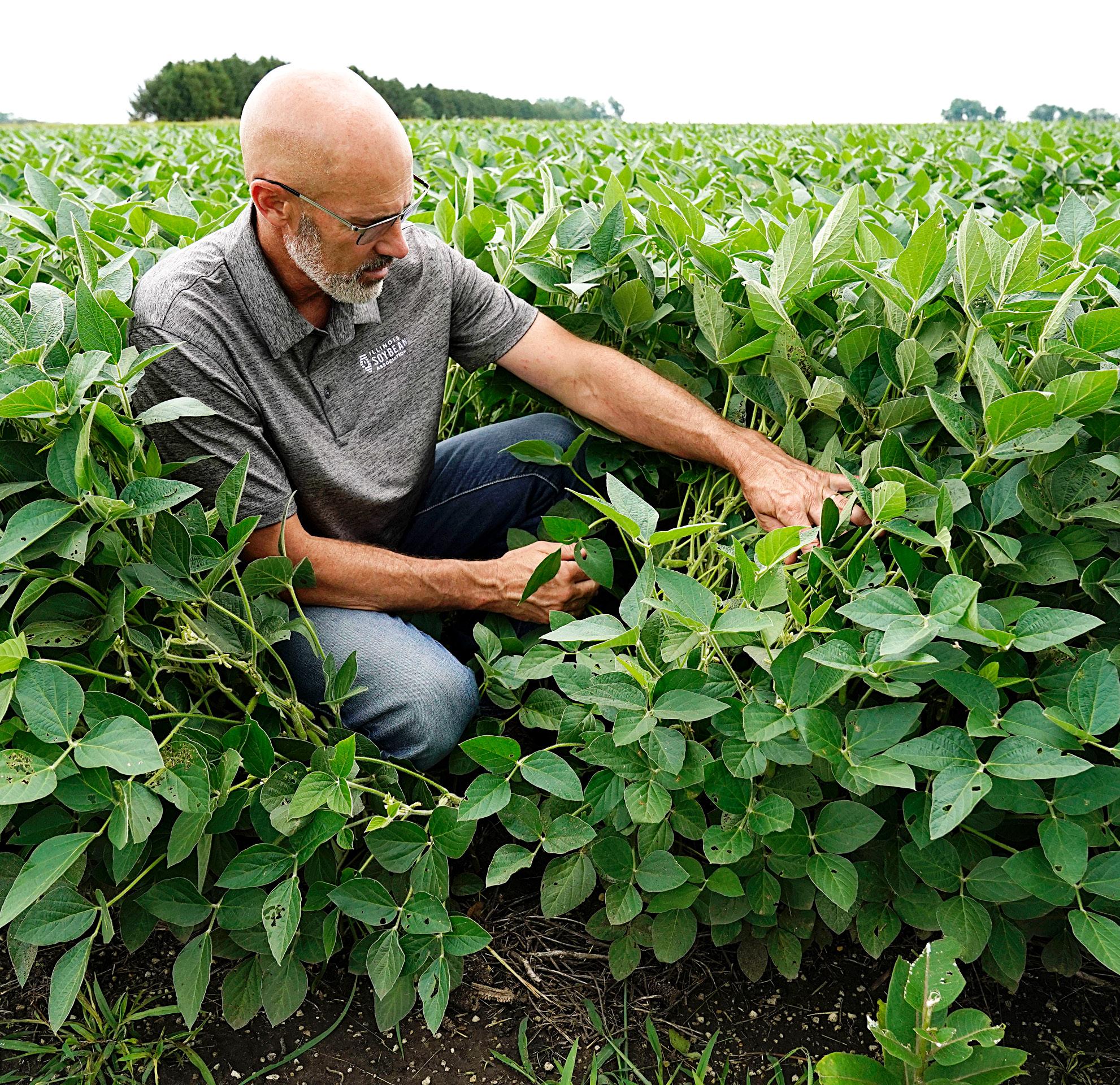
Even if the effort is only moderately successful, agriculture groups are hoping for new ways of meeting a growing global demand for food while generating more profit for farmers amid high fertilizer and fuel costs. As Andrew Larson with the Illinois Soybean Association put it, “It removes some of the hurdles and provides a lot more flexibility.”
In 2020, the U.S. exported wheat valued at $6.3 billion. The U.S. along with Russia, Australia and Canada usually lead the world in wheat exports, with Ukraine typically ranked
fifth, though its shipments will drop this year due to the war.
Double-cropping isn’t new in parts of the South and southern Midwest, which have the key advantage of longer growing seasons. Those warmer temperatures let farmers squeeze in a fall planting of one crop – usually winter wheat – that is dormant over the winter and then grows and can be harvested in late spring, just as farmers plant a second crop – typically soybeans.
The problem comes when cool weather delays the spring harvest of wheat, which in turn delays the planting of soybeans. And that’s where the USDA’s new effort could ease the risk of
a costly planting backup.
The USDA’s Risk Management Agency would streamline crop insurance approvals for farmers planting a second crop in more than 1,500 counties where double-cropping seems viable. The agency also would work with crop insurers and farm groups to promote a greater availability of coverage in other counties.
In announcing its effort, the USDA said it was aiming to “stabilize food prices and feed Americans and the world amidst continuing challenges such as the COVID-19 pandemic, supply chain disruptions, and the invasion of Ukraine by Russia.”
The USDA didn’t mention climate change, but the agency and other experts have long said warming temperatures will spur farmers to rethink what they grow and how.
The new program is focused more on the Russian invasion of Ukraine, which is a leading supplier of wheat to people in Africa and the Middle East. After the invasion, wheat prices nearly doubled to over $12 a bushel, though since then prices have steadily dropped as supply concerns have eased, in part because of agreements that have allowed for the export of some Ukraine wheat.
The USDA didn’t respond to a request for details about how
many farmers the agency hopes will begin double-cropping or how much U.S production could increase.
Farmers who double-crop often have smaller crops, but two smaller crops would still be significantly larger than an individual crop.
A study published in August by the University of Illinois and Ohio State University found that was certainly the case this year, as high wheat prices resulted in double-cropped land in southern Illinois bringing a projected $251 per acre return for wheat and soybeans, which is $81 higher than a stand-alone soybean crop. The double-crop benefit was less dramatic in other parts of the state and could be less if wheat prices drop.
Mark Lehenbauer, who raises livestock and grows row crops near Palmyra, Missouri, said he’s double-cropped for years and finds it reliably profitable. Still, he cautions that there is a years-long learning curve as farmers learn how to accomplish the task of planting one crop just as they need to harvest another.
And Lehenbauer acknowledged that many farmers may simply be reluctant to take on the added risks or extra workload.
“There are a lot of extra steps in there,” Lehenbauer said. “It adds some complexity.”
Ultimately, the biggest factor behind whether farmers begin growing an extra crop of wheat is what price they can get for the crop, said Pat Westhoff, director of the Food and Agricultural Policy Research Institute at the University of Missouri. Although prices have dropped from the peaks soon after Russia’s invasion of Ukraine, they remain at the still profitable level of nearly $8 a bushel.
“It really comes down to where wheat prices go in the future,” he said. “Even with the drop in prices we’ve seen, wheat prices are pretty high so there should be a little more incentive for wheat double cropping in this next year than there has been.”
